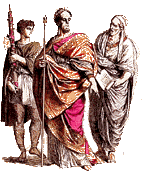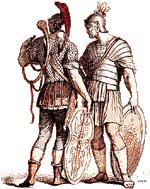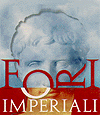Life in
Antique Rome
The men
 The world of the antique Romans was divided into two
macro-categories: free men and slaves, first Roman citizens and foreigners
("peregrini"). The world of the antique Romans was divided into two
macro-categories: free men and slaves, first Roman citizens and foreigners
("peregrini").
Slaves were everywhere, often prisoners of war and sometimes free citizens that were sold
to settle their debts. Slaves were considered goods and could be sold. Without political
or judicial rights, they were assigned hard work as well as intellectual duties, depending
on their level of instruction. In rare cases, they could be freed by their master.
Every free citizen had three names: the "praenomen" (baptismal name), the
"nomen" (family name) and the "cognomen" (last name). they usually
dressed simple; a knee-length tunic and a hooded cloak. On special occasions they wore a
"toga", a semicircular draped cloak made of wool. Common citizens wore white
togas while those of senators and cavalry had togas with a purple border. This last type
of toga was also worn by male youths under the age of 17 ("pueri").
 The man was the "pater
familias", or head of the family. The concept of family had a larger significance to
the Romans: consisting not only of husband, wife and children, but also of grandparents,
in-laws, nieces, and nephews. It s function was to transmit patrimony. More information in
the chapter on women. The man was the "pater
familias", or head of the family. The concept of family had a larger significance to
the Romans: consisting not only of husband, wife and children, but also of grandparents,
in-laws, nieces, and nephews. It s function was to transmit patrimony. More information in
the chapter on women.
> The women
> Cuisine and antique
Roman recipes
> The houses
> Live images from Rome
through the remote control camera
> Places and
constructions as seen today and as seen during Antique Rome
In the other chapters you can find: the latest
news on excavation advancements in the Imperial Forum area, the history of Rome, sayings
and habits of the Antique Romans. Select a chapter among the four titles in the black
column on the right.
|



